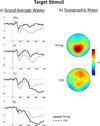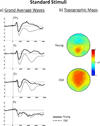Investigating the age-related "anterior shift" in the scalp distribution of the P3b component using principal component analysis
- PMID: 24660980
- PMCID: PMC4630002
- DOI: 10.1111/psyp.12206
Investigating the age-related "anterior shift" in the scalp distribution of the P3b component using principal component analysis
Abstract
An age-related "anterior shift" in the distribution of the P3b is often reported. Temporospatial principal component analysis (PCA) was used to investigate the basis of this observation. ERPs were measured in young and old adults during a visual oddball task. PCA revealed two spatially distinct factors in both age groups, identified as the posterior P3b and anterior P3a. Young subjects generated a smaller P3a than P3b, while old subjects generated a P3a that did not differ in amplitude from their P3b. Rather than having a more anteriorly distributed P3b, old subjects produced a large, temporally overlapping P3a. The pattern of the age-related "anterior shift" in the P3 was similar for target and standard stimuli. The increase in the P3a in elderly adults may not represent a failure to habituate the novelty response, but may reflect greater reliance on executive control operations (P3a) to carry out the categorization/updating process (P3b).
Keywords: Aging; Anterior shift; Cognition; EEG/ERP; P3; PCA.
Copyright © 2014 Society for Psychophysiological Research.
Figures





References
-
- American Psychiatric Association. Diagnostic and statistical manual of mental disorders. 4th ed. Washington, DC: American Psychological Association; 1994.
-
- Anderer P, Pascual-Marqui RD, Semlitsch HV, Saletu B. Differential effects of normal aging on sources of standard N1, target N1 and target P300 auditory event-related brain potentials revealed by low resolution electromagnetic tomography (LORETA) Electroencephalography and Clinical Neurophysiology. 1998;108(2):160–174. - PubMed
-
- Barcelo F, Escera C, Corral MJ, Perianez JA. Task switching and novelty processing activate a common neural network for cognitive control. Journal of Cognitive Neuroscience. 2006;18(10):1734–1748. - PubMed
-
- Barcelo F, Perianez JA, Knight RT. Think differently: A brain orienting response to task novelty. Neuroreport. 2002;13(15):1887–1892. - PubMed
Publication types
MeSH terms
Grants and funding
LinkOut - more resources
Full Text Sources
Other Literature Sources
Medical

